Implementing a Data Warehouse with Microsoft SQL Server 2012 v13.0
Question 1
A SQL Server Integration Services (SSIS) project has been deployed to the SSIS catalog.
The project includes a project Connection Manager to connect to the data warehouse.
The SSIS catalog includes two Environments:
-> Development
-> QA
Each Environment defines a single Environment Variable named ConnectionString of type string. The value of each variable consists of the connection string to the development or
QA data warehouses.
You need to be able to execute deployed packages by using either of the defined
Environments.
Which three actions should you perform in sequence? (To answer, move the appropriate actions from the list of actions to the answer area and arrange them in the correct order.)
Answer : 
Question 2
You are installing SQL Server Data Quality Services (DQS).
You need to give specific users access to the Data Quality Server.
Which SQL Server application should you use?
- A. SQL Server Configuration Manager
- B. SQL Server Data Tools
- C. SQL Server Management Studio
- D. Data Quality Client
Answer : C
Explanation:
Ref: http://msdn.microsoft.com/en-us/library/hh213045.aspx
Question 3
You are installing SQL Server Data Quality Services (DQS).
You need to give users belonging to a specific Active Directory group access to the Data
Quality Server.
Which SQL Server application should you use?
- A. Data Quality Client with administrative credentials
- B. SQL Server Configuration Manager with local administrative credentials
- C. SQL Server Data Tools with local administrative permissions
- D. SQL Server Management Studio with administrative credentials
Answer : D
Question 4
You are creating a SQL Server Master Data Services (MDS) model for a company.
The source data for the company is stored in a single table that contains the manager-to- subordinate relationships.
You need to create a hierarchy representing the organizational structure of the company.
Which hierarchy type should you use?
- A. Natural
- B. Explicit
- C. Parent
- D. Recursive
Answer : D
Reference: http://technet.microsoft.com/en-us/library/ff487006.aspx
Reference: http://msdn.microsoft.com/en-us/library/ee633747.aspx
Reference: http://technet.microsoft.com/en-us/library/ee633759.aspx
Question 5
You are creating a SQL Server Integration Services (SSIS) package that implements a
Type 3 Slowly Changing Dimension (SCD).
You need to add a task or component to the package that allows you to implement the
SCD logic.
What should you use?
- A. a Data Conversion component
- B. an Execute SQL task that executes a MERGE statement on the database
- C. a Merge component
- D. an Expression task
Answer : C
Explanation:
Note: Type of Slowly Changing Dimensions Slowly Changing Dimensions are categorized into three types named: Type 1, Type 2, and Type3. The Type 1 SCD does not maintain the history of changing attributes, it overwrites values of the attributes. Type 2 maintains historical values for changing attributes. Type 3 that we do not use much maintains separate columns for changed attributes. SSIS SCD wizard supports both Type
1 and Type 2.
Using MERGE instead of SCD wizard Replacement of SCD wizard with MERGE is not a straightforward technique. If the SCD has both Type 1 and Type 2 types attributes, they need to be handled separately.
Question 6
You are using the Knowledge Discovery feature of the Data Quality Services (DQS) client application to modify an existing knowledge base.
In the mapping configuration, two of the three columns are mapped to existing domains in the knowledge base. The third column, named Team Type, does not yet have a domain.
You need to complete the mapping of the Team Type column.
What should you do?
- A. Add a column mapping for the Team Type column.
- B. Map a composite domain to the source column.
- C. Create a composite domain that includes the Team Type column.
- D. Add a domain for the Team Type column.
Answer : D
Explanation: References:
http://msdn.microsoft.com/en-us/library/ff877917.aspx
http://msdn.microsoft.com/en-us/library/hh213015.aspx
http://msdn.microsoft.com/en-us/library/gg524799.aspx
Question 7
You are reviewing the design of an existing fact table named factSales, which is loaded from a SQL Azure database by a SQL Server Integration Services (SSIS) package each day. The fact table has approximately 1 billion rows and is dimensioned by product, sales date, and sales time of day.
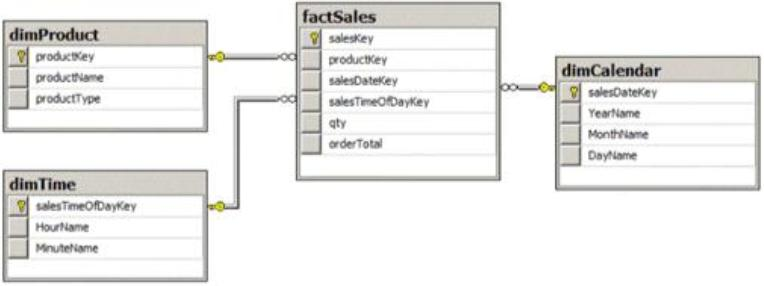
The database administrator is concerned about the growth of the database. Users report poor reporting performance against this database. Reporting requirements have recently changed and the only remaining report that uses this fact table reports sales by product name, sale month, and sale year. No other reports will be created against this table.
You need to reduce the report processing time and minimize the growth of the database.
What should you do?
- A. Partition the table by product type.
- B. Create a view over the fact table to aggregate sales by month.
- C. Change the granularity of the fact table to month.
- D. Create an indexed view over the fact table to aggregate sales by month.
Answer : C
Question 8
You manage a SQL Server Master Data Services (MDS) environment.
A new application requires access to the product data that is available in the MDS repository.
You need to design a solution that gives the application access to the product data with the least amount of development effort.
What should you do?
- A. Create a Subscription View in MDS.
- B. Access the product entity tables in the MDS database directly.
- C. Use SQL Server Integration Services (SSIS) to extract the data and put it in a staging database.
- D. Use change data capture on the product entity tables.
Answer : A
Question 9
You are designing an extract, transform, load (ETL) process with SQL Server Integration
Services (SSIS). Two packages, Package A and Package B, will be designed. Package A will execute Package B.
Both packages must reference a file path corresponding to an input folder where files will be located for further processing.
You need to design a solution so that the file path can be easily configured with the least administrative and development effort.
Which four actions should you perform in sequence? (To answer, move the appropriate actions from the list of actions to the answer area and arrange them in the correct order.)
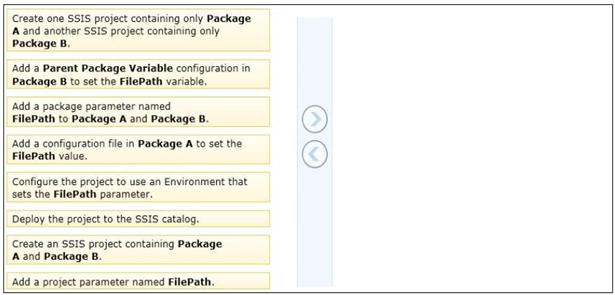
Answer : 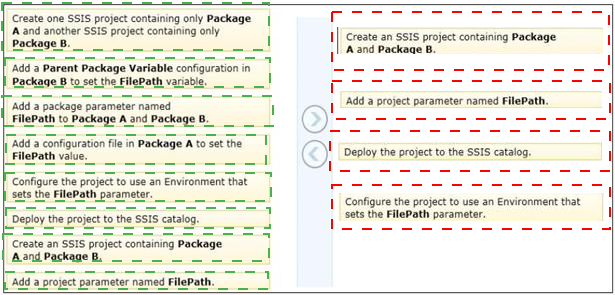
Question 10
You are creating a SQL Server Integration Services (SSIS) package to retrieve product data from two different sources. One source is hosted in a SQL Azure database. Each source contains products for different distributors.
Products for each distributor source must be combined for insertion into a single product table destination.
You need to select the appropriate data flow transformation to meet this requirement.
Which transformation types should you use? (Each correct answer presents a complete solution. Choose all that apply.)
- A. Multicast
- B. Merge Join
- C. Term Extraction
- D. union All
- E. Merge
Answer : D,E
Reference: http://msdn.microsoft.com/en-us/library/ms141703.aspx
Reference: http://msdn.microsoft.com/en-us/library/ms141775.aspx
Reference: http://msdn.microsoft.com/en-us/library/ms141020.aspx
Reference: http://msdn.microsoft.com/en-us/library/ms141809.aspx
Reference: http://msdn.microsoft.com/en-us/library/ms137701.aspx
Question 11
You are developing a SQL Server Integration Services (SSIS) package to insert new data into a data mart. The package uses a Lookup transformation to find matches between the source and destination.
The data flow has the following requirements:
New rows must be inserted.
Lookup failures must be written to a flat file.
In the Lookup transformation, the setting for rows with no matching entries is set to
Redirect rows to no match output. You need to configure the package to direct data into the correct destinations.
How should you design the data flow outputs? (To answer, drag the appropriate transformation from the list of answer options to the correct location in the answer area.)
Answer : 
Explanation:
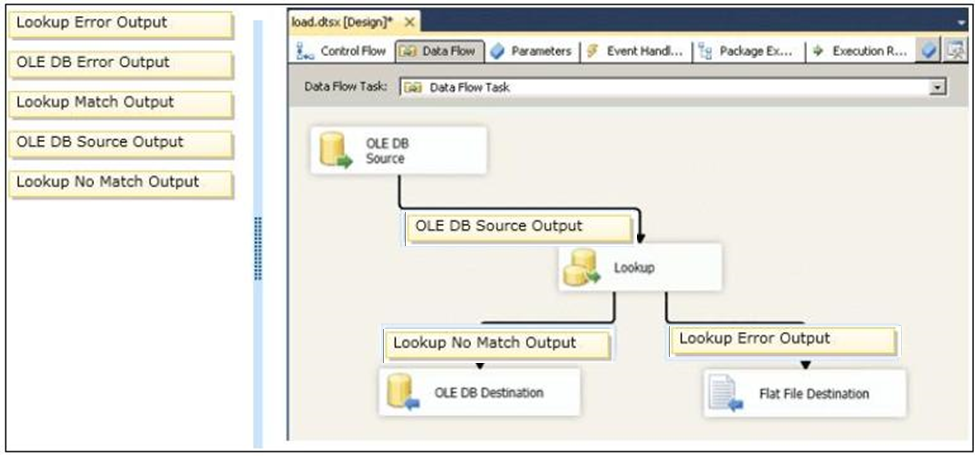
Records that have no match in the destination are new records and so should be inserted.
Any errors should be recorded in the flat file.
References:
http://msdn.microsoft.com/en-us/library/ms141821.aspx
http://msdn.microsoft.com/en-us/library/bb895366.aspx
https://www.simple-talk.com/sql/ssis/implementing-lookup-logic-in-sql-server-integration- services/
Question 12
You are reviewing the design of a customer dimension table in an existing data warehouse hosted on SQL Azure.
The current dimension design does not allow the retention of historical changes to customer attributes such as Postcode.
You need to redesign the dimension to enable the full historical reporting of changes to multiple customer attributes including Postcode.
What should you do?
- A. Add StartDate and EndDate columns to the customer dimension.
- B. Add an IsCurrent column to the customer dimension.
- C. Enable Snapshot Isolation on the data warehouse.
- D. Add CurrentValue and PreviousValue columns to the customer dimension.
Answer : A
Question 13
You are developing a SQL Server Integration Services (SSIS) package.
The package uses custom functionality that accesses a SQL Server database. The custom functionality must be implemented by using Language Integrated Query (LINQ).
You need to ensure that the LINQ code can be debugged at design time.
What should you select from the SSIS Toolbox? (To answer, drag the appropriate item to the correct location in the answer area.)
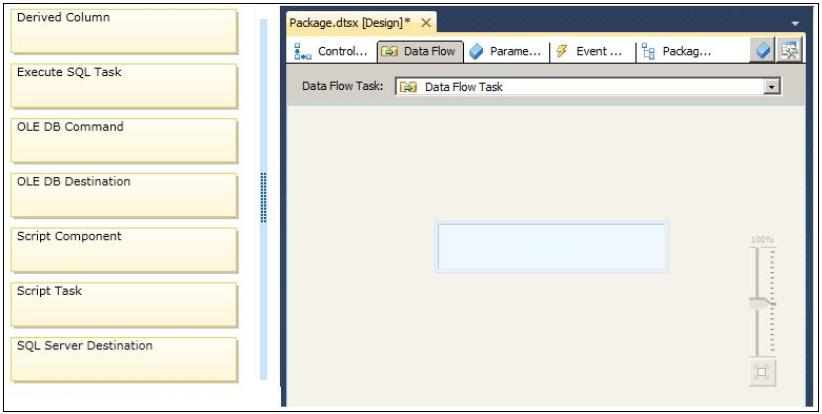
Answer : 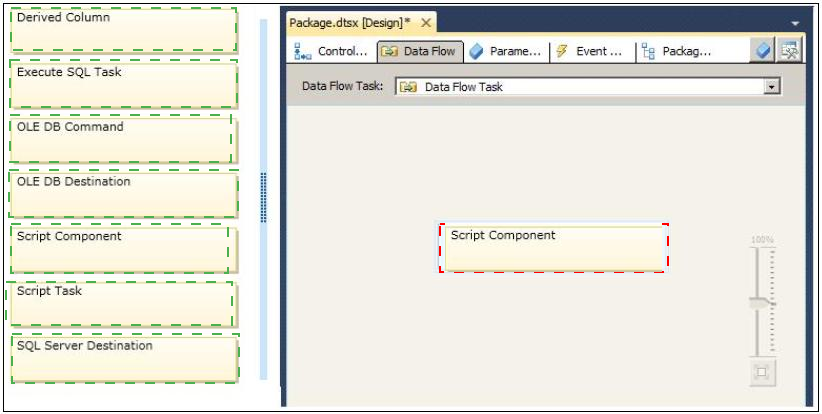
Question 14
You are designing a data warehouse with two fact tables. The first table contains sales per month and the second table contains orders per day.
Referential integrity must be enforced declaratively.
You need to design a solution that can join a single time dimension to both fact tables.
What should you do?
- A. Create a time mapping table.
- B. Change the level of granularity in both fact tables to be the same.
- C. Merge the fact tables.
- D. Create a view on the sales table.
Answer : B
Question 15
You are developing a SQL Server Integration Services (SSIS) package that imports data into a data warehouse.
You add an Execute SQL task to the control flow. The task must execute a simple INSERT statement.
The task has the following requirements:
The INSERT statement must use the value of a string package variable. The variable name is StringVar.
The Execute SQL task must use an OLE DB Connection Manager.
In the Parameter Mapping tab of the Execute SQL task, StringVar has been added as the only parameter.
You must configure the SQLStatement property of the Execute SQL task.
Which SQL statement should you use?
- A. INSERT INTO dbo.Table (variablevalue) VALUES (@StringVar)
- B. INSERT INTO dbo.Table (variablevalue) VALUES ($Project::StringVar)
- C. INSERT INTO dbo.Table (variablevalue) VALUES (?)
- D. INSERT INTO dbo.Table (variablevalue) VALUES ($Package::StringVar)
Answer : C